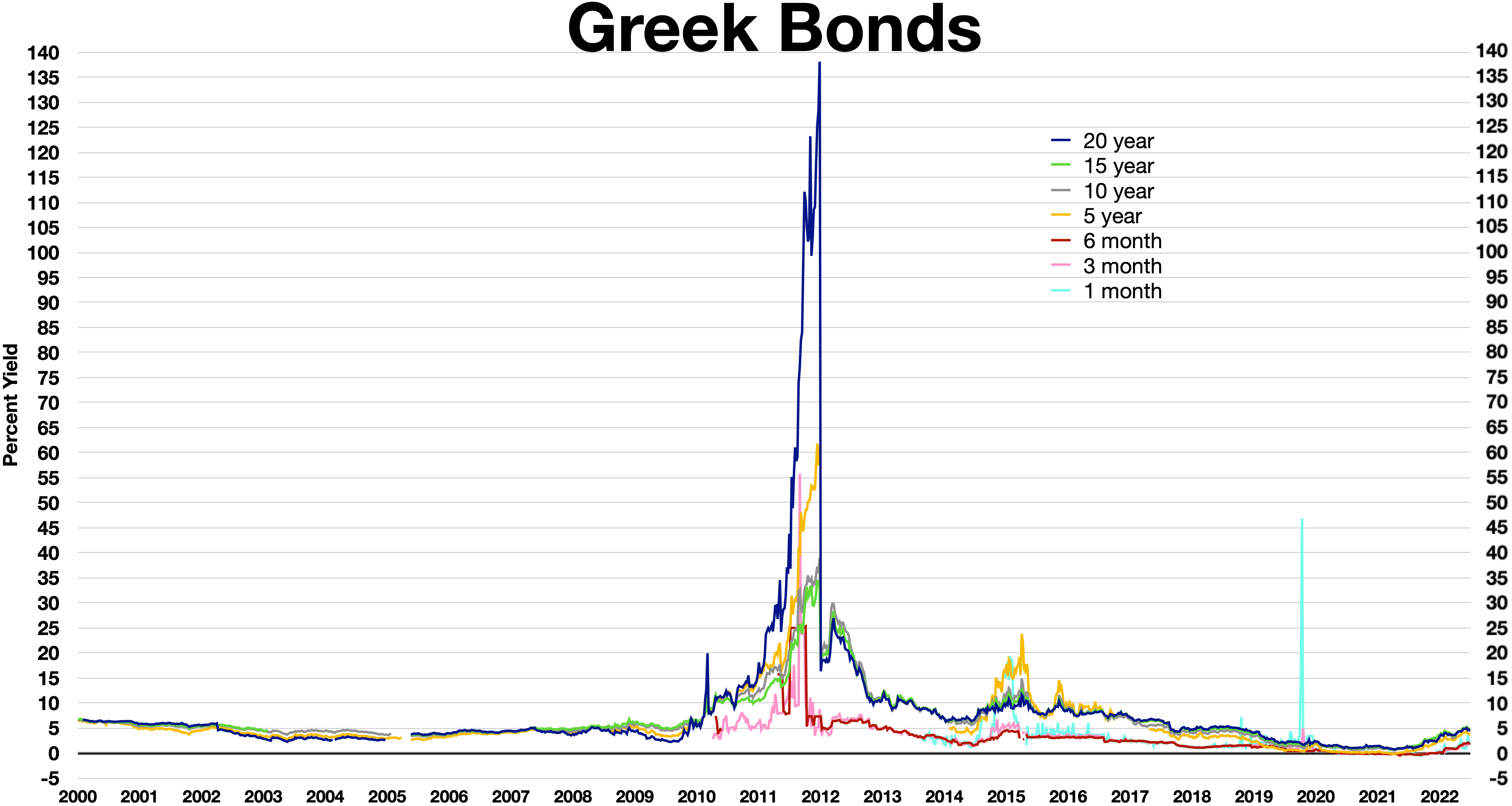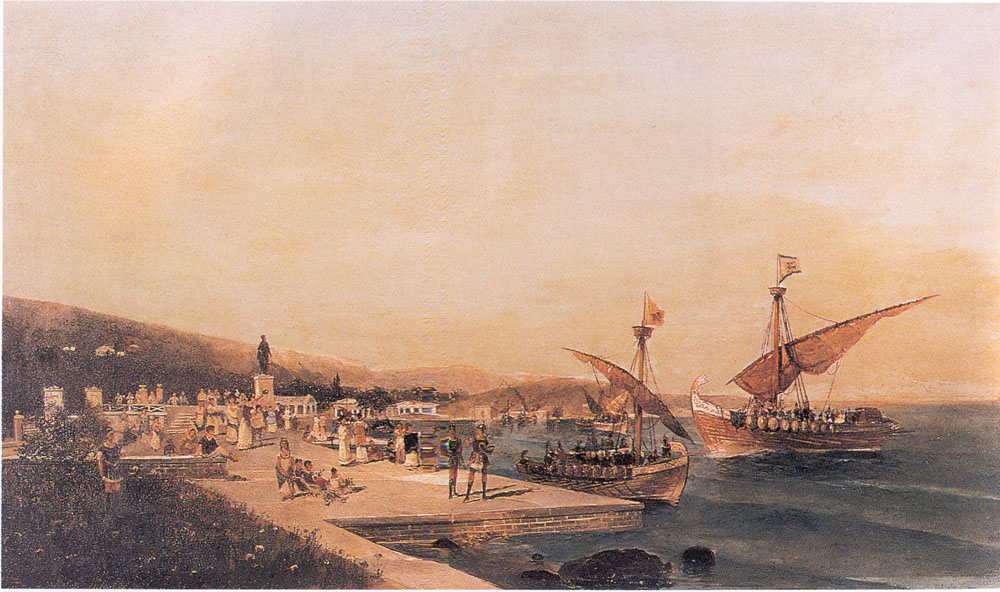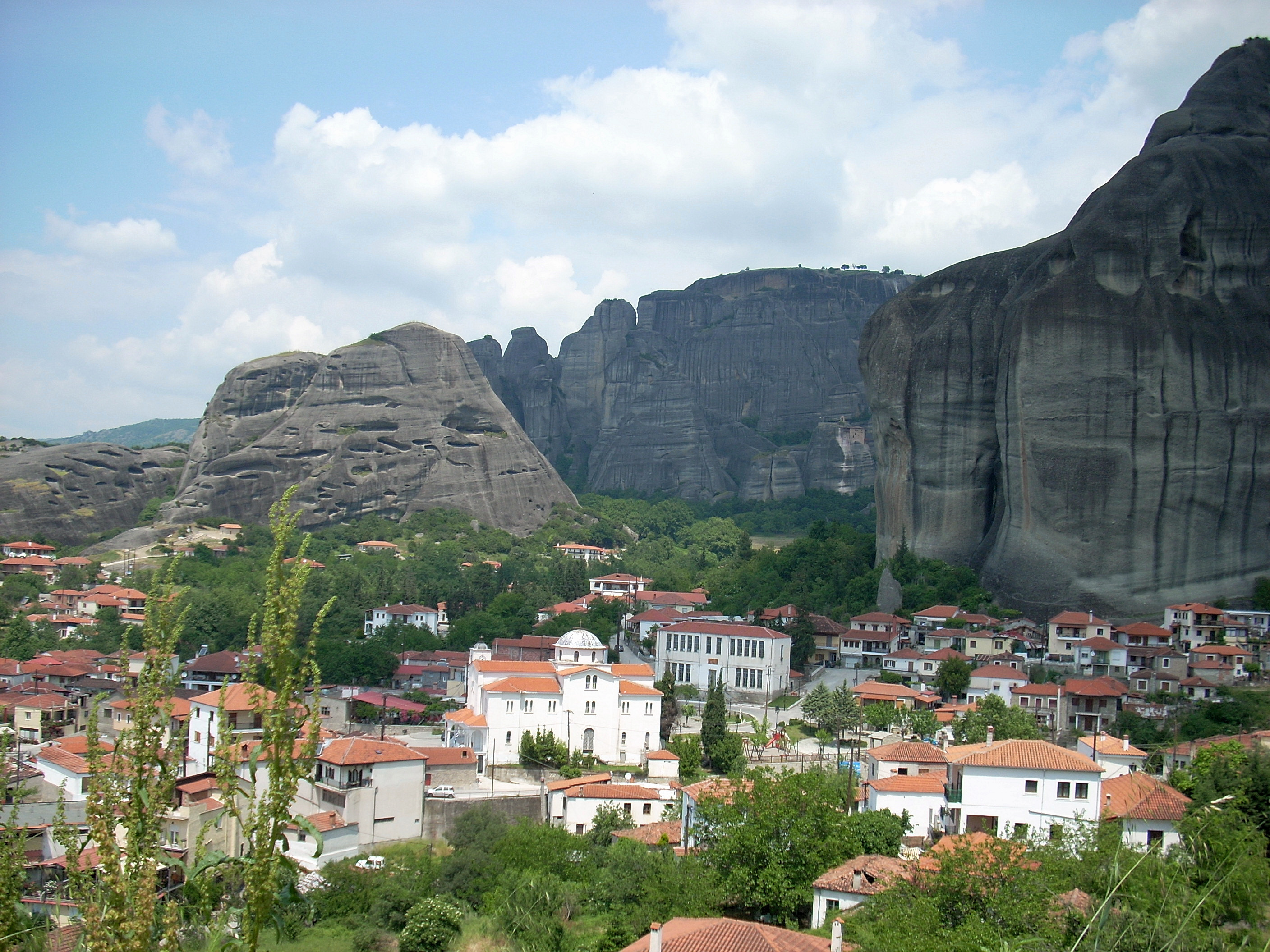|
Trikala Railway Station
Trikala railway station ( el, Σιδηροδρομικός σταθμός Τρικάλων) is a railway station in Trikala, Thessaly, Greece. The station is served by regional trains between Palaiofarsalos railway station, Palaiofarsalos and Kalambaka railway station, Kalambaka. History The station opened on 16 June 1886 as an intermittent station of Thessaly Railways. The original station building (and the line) was designed by the Italy, Italian Evaristo de Chirico, (father of Giorgio de Chirico). The line was authorised by the Greek government under the law AMH’/22.6.1882. soon after the liberation of Central Greece from the Ottoman Empire, Ottomans. Trikala was one of the mainline stations (as shown by the impressive original station building) along with Farsala railway station, Farsala and Kalambaka railway station, Kalambaka. After the World War I, First World War, the Greek state planned the ambitious construction of several new rail lines and links, including a standard ... [...More Info...] [...Related Items...] OR: [Wikipedia] [Google] [Baidu] |
Trikala
Trikala ( el, Τρίκαλα; rup, Trikolj) is a city in northwestern Thessaly, Greece, and the capital of the Trikala regional unit. The city straddles the Lithaios river, which is a tributary of Pineios. According to the Greek National Statistical Service, Trikala is populated by 81,355 inhabitants (2011), while in total the Trikala regional unit is populated by 131,085 inhabitants (2011). Trikala is a lively Greek city with picturesque monuments and old neighborhoods with traditional architecture. The city is near Meteora and also near the mountain range of south Pindus, where there are many destinations (i.e. Pyli's stone bridge, Elati, Pertouli, Palaiokarya's stone bridge and waterfall, Pertouli Ski Center etc.). History Antiquity The region of Trikala has been inhabited since prehistoric times. The first indications of permanent settlement have been uncovered in the cave of Theopetra, and date back to approx. 49,000 BC. Neolithic settlements dating back to 6,000 B ... [...More Info...] [...Related Items...] OR: [Wikipedia] [Google] [Baidu] |
Evaristo De Chirico
Evaristo is both a given name and a surname. Notable people with the name include: Given name: * Evaristo Avalos (born 1933), Mexican equestrian * Evaristo Barrera (1911–1982), Argentine football striker * Evaristo Baschenis (1617–1677), Italian Baroque painter * Evaristo Beccalossi (born 1956), Italian footballer * Evaristo Carazo (1821–1889), President of Nicaragua * Evaristo Carriego (1883–1912), Argentine poet * Evaristo Carvalho (born 1942), President and former prime minister of São Tomé and Príncipe * Evaristo Conrado Engelberg (1853–1932), Brazilian mechanical engineer and inventor * Evaristo Coronado (born 1960), Costa Rican soccer striker * Evaristo Costa (born 1976), Brazilian journalist * Evaristo da Veiga (1799–1837), Brazilian poet, journalist, politician and bookseller * Evaristo de Churruca y Brunet (1841–1917), Spanish engineer * Evaristo de Macedo (born 1933), former Brazilian footballer * Evaristo de Moraes Filho, Brazilian lawyer * Evaristo Endanc ... [...More Info...] [...Related Items...] OR: [Wikipedia] [Google] [Baidu] |
Greek Government-debt Crisis
Greece faced a sovereign debt crisis in the aftermath of the financial crisis of 2007–2008. Widely known in the country as The Crisis ( Greek: Η Κρίση), it reached the populace as a series of sudden reforms and austerity measures that led to impoverishment and loss of income and property, as well as a small-scale humanitarian crisis. In all, the Greek economy suffered the longest recession of any advanced mixed economy to date. As a result, the Greek political system has been upended, social exclusion increased, and hundreds of thousands of well-educated Greeks have left the country. The Greek crisis started in late 2009, triggered by the turmoil of the world-wide Great Recession, structural weaknesses in the Greek economy, and lack of monetary policy flexibility as a member of the Eurozone. The crisis included revelations that previous data on government debt levels and deficits had been underreported by the Greek government: the official forecast for the 2009 budg ... [...More Info...] [...Related Items...] OR: [Wikipedia] [Google] [Baidu] |
Thessaloniki
Thessaloniki (; el, Θεσσαλονίκη, , also known as Thessalonica (), Saloniki, or Salonica (), is the second-largest city in Greece, with over one million inhabitants in its Thessaloniki metropolitan area, metropolitan area, and the capital city, capital of the geographic regions of Greece, geographic region of Macedonia (Greece), Macedonia, the administrative regions of Greece, administrative region of Central Macedonia and the Decentralized Administration of Macedonia and Thrace. It is also known in Greek language, Greek as (), literally "the co-capital", a reference to its historical status as the () or "co-reigning" city of the Byzantine Empire alongside Constantinople. Thessaloniki is located on the Thermaic Gulf, at the northwest corner of the Aegean Sea. It is bounded on the west by the delta of the Vardar, Axios. The Thessaloniki (municipality), municipality of Thessaloniki, the historical center, had a population of 317,778 in 2021, while the Thessaloniki metro ... [...More Info...] [...Related Items...] OR: [Wikipedia] [Google] [Baidu] |
Athens
Athens ( ; el, Αθήνα, Athína ; grc, Ἀθῆναι, Athênai (pl.) ) is both the capital and largest city of Greece. With a population close to four million, it is also the seventh largest city in the European Union. Athens dominates and is the capital of the Attica region and is one of the world's oldest cities, with its recorded history spanning over 3,400 years and its earliest human presence beginning somewhere between the 11th and 7th millennia BC. Classical Athens was a powerful city-state. It was a centre for the arts, learning and philosophy, and the home of Plato's Academy and Aristotle's Lyceum. It is widely referred to as the cradle of Western civilization and the birthplace of democracy, largely because of its cultural and political influence on the European continent—particularly Ancient Rome. In modern times, Athens is a large cosmopolitan metropolis and central to economic, financial, industrial, maritime, political and cultural life in Gre ... [...More Info...] [...Related Items...] OR: [Wikipedia] [Google] [Baidu] |
Hellenic State Railways
Hellenic State Railways or SEK ( el, Σιδηρόδρομοι Ελληνικού Κράτους, ''Sidirodromi Ellinikou Kratous''; Σ.Ε.Κ.) was a Greek public sector entity (legal person of public law, el, Ν.Π.Δ.Δ.) which was established in 1920 and operated most Greek railway lines until 1970. History The Hellenic State Railways took over the standard gauge railway line from Piraeus to Papapouli at the pre-1912 borders, the extension from Papapouli to Platy and most of the former Ottoman railway lines that were within the Greek borders after 1919. These lines were: * ''Piraeus, Demerli & Frontiers Railway'' ( el, Σιδηρόδρομος Πειραιώς-Δεμερλή-Συνόρων), also known as * Part of the former ''Thessaloniki & Monastir Railway'' (french: Chemin de fer de Salonique à Monastir or SM) * Part of or CO, between Thessaloniki and Idomeni. The line from Alexandroupolis to Ormenio was transferred to the French-Hellenic Railway Company (, CFFH) of Ev ... [...More Info...] [...Related Items...] OR: [Wikipedia] [Google] [Baidu] |
Volos
Volos ( el, Βόλος ) is a coastal port city in Thessaly situated midway on the Greek mainland, about north of Athens and south of Thessaloniki. It is the sixth most populous city of Greece, and the capital of the Magnesia regional unit of the Thessaly Region. Volos is also the only outlet to the sea from Thessaly, the country's largest agricultural region. With a population of 144,449 (2011), the city is an important industrial centre, and its port provides a bridge between Europe and Asia. Volos is the newest of the Greek port cities, with a large proportion of modern buildings erected following catastrophic earthquakes in 1955. It includes the municipal units of Volos, Nea Ionia and Iolkos, as well as smaller suburban communities. The economy of the city is based on manufacturing, trade, services and tourism. Home to the University of Thessaly, the city also offers facilities for conferences, exhibitions and major sporting, cultural and scientific events. Volos parti ... [...More Info...] [...Related Items...] OR: [Wikipedia] [Google] [Baidu] |
Veroia
Veria ( el, Βέροια or Βέρροια), officially transliterated Veroia, historically also spelled Berea or Berœa, is a city in Central Macedonia, in the geographic region of Macedonia, northern Greece, capital of the regional unit of Imathia. It is located north-northwest of the capital Athens and west-southwest of Thessaloniki. Even by the standards of Greece, Veria is an old city; first mentioned in the writings of Thucydides in 432 BC, there is evidence that it was populated as early as 1000 BC. Veria was an important possession for Philip II of Macedon (father of Alexander the Great) and later for the Romans. Apostle Paul famously preached in the city, and its inhabitants were among the first Christians in the Empire. Later, under the Byzantine and Ottoman empires, Veria was a center of Greek culture and learning. Today Veria is a commercial center of Central Macedonia, the capital of the regional unit of Imathia and the seat of a Church of Greece Metropolitan b ... [...More Info...] [...Related Items...] OR: [Wikipedia] [Google] [Baidu] |
Kozani
Kozani ( el, Κοζάνη, ) is a city in northern Greece, capital of Kozani (regional unit), Kozani regional unit and of Western Macedonia. It is located in the western part of Macedonia (Greece), Macedonia, in the northern part of the Aliakmonas, Aliakmonas river valley. The city lies above sea level, northwest of the artificial lake Polyfytos, south-west of Thessaloniki, between the mountains Pierian Mountains, Pieria, Vermion Mountains, Vermio, Vourinos and Askio. The population of the Kozani municipality is over 70,000 people. The climate of the area is continental with cold and dry winters, and hot summers. Kozani is the home of the University of Western Macedonia, with about 15,000 students from all over Greece and other places. It is also the seat of West Macedonia's court of appeal, police department, fire brigade, the seat of the Hellenic Army I Army Corps, 1st Army Corps of the Hellenic Army and of the Diocese of Servia and Kozani, Bishop of ''Servia and Kozani''. O ... [...More Info...] [...Related Items...] OR: [Wikipedia] [Google] [Baidu] |
Kalambaka
Kalabaka ( el, Καλαμπάκα, ''Kalabáka'', alternative transliterations are ''Kalambaka'' and ''Kalampaka'') is a town and seat of the municipality of Meteora in the Trikala regional unit, part of Thessaly in Greece. The population was 12,000 at the 2011 census, of which 8,330 in the town proper. The Meteora monasteries are located near the town. Kalabaka is the northwestern terminal of the old Thessaly Railways, now part of OSE. History A Greek inscription on the wall of one of the town's oldest churches (Saint John the Baptist) testifies to the existence of an ancient Greek settlement under the name Aiginion. In the 10th century AD, it was known as Stagoi (Σταγοί), a Byzantine fortress and bishopric (the name is still in use for the town by the Greek Orthodox Church). Of its medieval monuments, only the cathedral, the Church of the Dormition, survives. It was a late 11th- or early 12th-century building, built on the remains of an earlier, late antique chu ... [...More Info...] [...Related Items...] OR: [Wikipedia] [Google] [Baidu] |
World War I
World War I (28 July 1914 11 November 1918), often abbreviated as WWI, was one of the deadliest global conflicts in history. Belligerents included much of Europe, the Russian Empire, the United States, and the Ottoman Empire, with fighting occurring throughout Europe, the Middle East, Africa, the Pacific, and parts of Asia. An estimated 9 million soldiers were killed in combat, plus another 23 million wounded, while 5 million civilians died as a result of military action, hunger, and disease. Millions more died in genocides within the Ottoman Empire and in the 1918 influenza pandemic, which was exacerbated by the movement of combatants during the war. Prior to 1914, the European great powers were divided between the Triple Entente (comprising France, Russia, and Britain) and the Triple Alliance (containing Germany, Austria-Hungary, and Italy). Tensions in the Balkans came to a head on 28 June 1914, following the assassination of Archduke Franz Ferdin ... [...More Info...] [...Related Items...] OR: [Wikipedia] [Google] [Baidu] |
Farsala Railway Station
Farsala ( el, Φάρσαλα), known in Antiquity as Pharsalos ( grc, Φάρσαλος, la, Pharsalus), is a city in southern Thessaly, in Greece. Farsala is located in the southern part of Larissa regional unit, and is one of its largest towns. Farsala is an economic and agricultural centre of the region. Cotton and livestock are the main agricultural products, and many inhabitants are employed in the production of textile. The area is mostly famous for being the birthplace of Achilles, a mythical ancient Greek hero and the sight of a major battle between Roman generals Gaius Julius Caesar and Gnaeus Pompeius in 48 BC. Geography Farsala lies at the southern edge of the Thessalian Plain, 4 km south of the river Enipeas. The Greek National Road 3 (Larissa - Lamia) and the Greek National Road 30 (Karditsa - Volos) pass through the town. The Palaiofarsalos railway station (litt. "''Ancient Pharsalus''"), on the line from Athens to Thessaloniki and head of the branch li ... [...More Info...] [...Related Items...] OR: [Wikipedia] [Google] [Baidu] |




_Sarakli-Stavros_in_Central_Makedonia_(Greece)_during_WW1.jpg)



